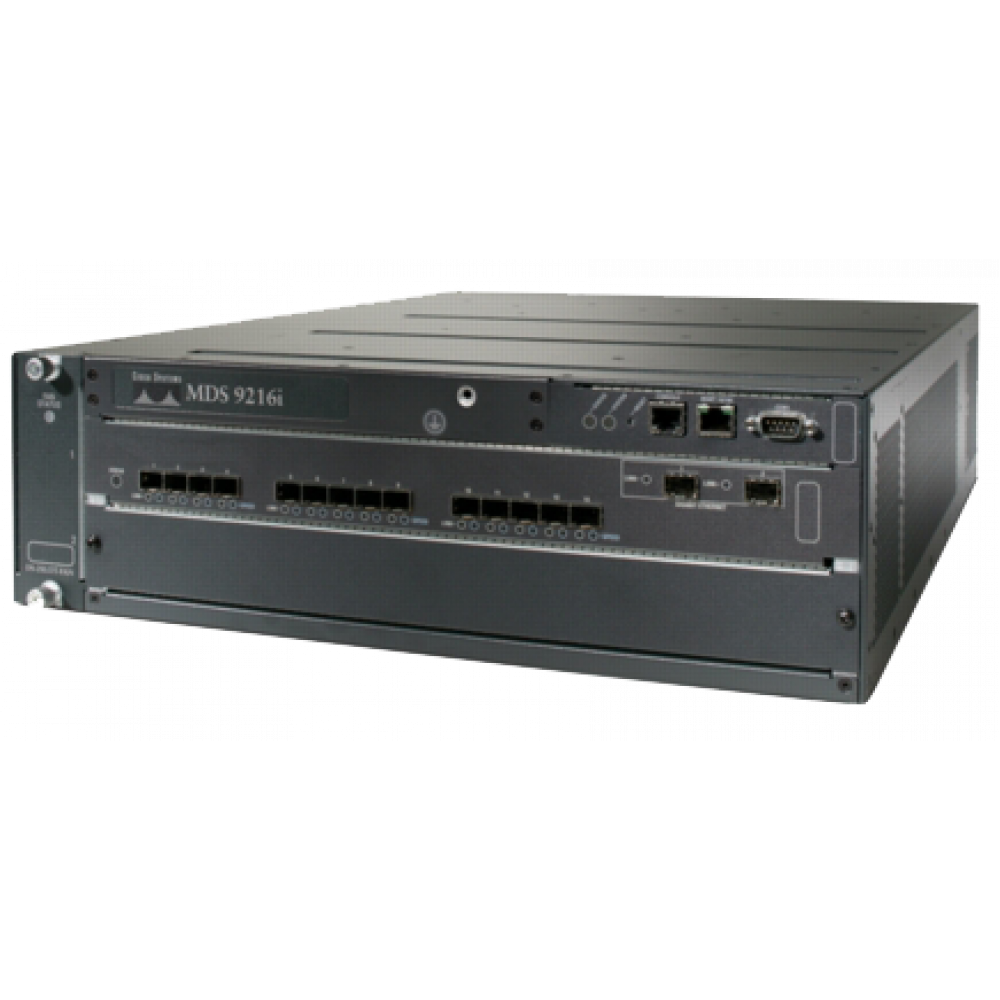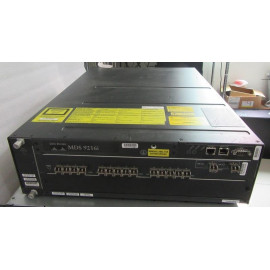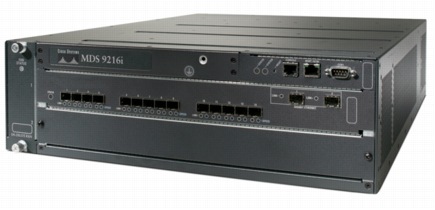PRODUCT OVERVIEW
The Cisco MDS 9216i (Figure 1) brings new capability to the fabric switch market. Sharing a consistent architecture with the Cisco MDS 9500 Series, the Cisco MDS 9216i integrates both Fibre Channel and IP storage services in a single system to allow maximum flexibility in user configurations. With 14 2-Gbps Fibre Channel ports, two Gigabit Ethernet IP storage services ports, and a modular expansion slot, the Cisco MDS 9216i is ideally suited for enterprise storage networks that require high-performance SAN extension or cost-effective IP storage connectivity.
This high level of integration gives Cisco MDS 9216i users the benefits of a multiprotocol system without sacrificing Fibre Channel port density. The expansion slot on the Cisco MDS 9216i allows for the addition of any Cisco MDS 9000 Family switching module, so users can add additional Fibre Channel ports and/or additional IP ports. Alternatively, the expansion slot can be used for a variety of Cisco MDS 9000 Family services modules, thereby providing an unparalleled level of storage services in a single, highly available 3-rack unit (RU) system.
Cisco MDS 9216i Multilayer Fabric Switch
KEY FEATURES AND BENEFITS
The Cisco ® MDS 9216i Multilayer Fabric Switch is designed for building mission-critical enterprise storage networks that take advantage of the cost-effectiveness and ubiquity of IP for more robust business continuance services. Using both Fibre Channel and IP in a single module, the Cisco MDS 9216i offers the following important features:
• Integrated Fibre Channel and IP storage services in an optimized form factor-Supports 14 2-Gbps Fibre Channel interfaces for high-performance storage area network (SAN) connectivity and two Gigabit Ethernet ports for Fibre Channel over IP (FCIP) and Small Computer System Interface over IP (iSCSI) storage services.
• Integrated hardware-based VSANs and Inter-VSAN Routing (IVR)-Enables deployment of large-scale multisite and heterogeneous SAN topologies. Integration into port-level hardware allows any port within a system or fabric to be partitioned into any VSAN. Integrated hardware-based inter-VSAN routing provides line-rate routing between any ports within a system or fabric without the need for external routing appliances.
• High-performance Inter-Switch Links (ISLs)-Supports up to 16 Fibre Channel links in a single PortChannel. Links can span any port on any module within a chassis for added scalability and resilience. Up to 3500 buffer-to-buffer credits can be assigned to a single Fibre Channel port to extend storage networks over unprecedented distances.
• Intelligent network services-Uses virtual SAN (VSAN) technology for hardware-enforced, isolated environments within a single physical fabric; access control lists (ACLs) for hardware-based intelligent frame processing; and advanced traffic management features such as Fibre Channel Congestion Control (FCC) and fabric-wide quality of service (QoS) to facilitate migration from SAN islands to enterprise-wide storage networks.
• Advanced FICON services-Supports FICON environments, including cascaded FICON fabrics, VSAN-enabled intermix of mainframe and open systems environments, and N_Port ID virtualization for mainframe Linux partitions. CUP (Control Unit Port) support enables in-band management of Cisco MDS 9200 Series switches from the mainframe management console.
• Comprehensive network security framework-Supports RADIUS and TACACS+, Fibre Channel Security Protocol (FC-SP), Secure File Transfer Protocol (SFTP), Secure Shell (SSH) Protocol, and Simple Network Management Protocol Version 3 (SNMPv3) implementing Advanced Encryption Standard (AES), VSANs, hardware-enforced zoning, ACLs, and per-VSAN role-based access control. Additionally, the Gigabit Ethernet ports offer IP security (IPSec) authentication, data integrity, and hardware-assisted data encryption for FCIP and iSCSI.
• Sophisticated diagnostics-Provides intelligent diagnostics, protocol decoding, and network analysis tools as well as integrated Call Home capability for added reliability, faster problem resolution, and reduced service costs.
• Open platform for intelligent storage applications-Provides the intelligent services necessary for hosting and/or accelerating storage applications such as network-hosted volume management, data migration and backup. Storage services modules can be installed in any Cisco MDS 9500 or MDS 9200 series chassis to provide application hosting and/or acceleration intelligence in the fabric.
• FCIP for remote SAN extension
– Simplifies data-protection and business continuance strategies by enabling backup, remote replication, and other disaster recovery services over WAN distances using open-standard FCIP tunneling.
– Optimizes utilization of WAN resources for backup and replication by tunneling up to three virtual ISLs on a single Gigabit Ethernet port and enabling hardware-based compression, hardware-based encryption, FCIP Write Acceleration, and FCIP Tape Acceleration.
– Preserves Cisco MDS 9000 Family enhanced capabilities, including VSANs, advanced traffic management, and network security across remote connections.
• iSCSI for extension of SAN to Ethernet-attached servers
– Extends the benefits of Fibre Channel SAN-based storage to Ethernet-attached servers at a lower cost than possible using Fibre Channel interconnect alone.
– Increases storage utilization and availability through consolidation of IP and Fibre Channel block storage.
– Transparent operation preserves the capability of existing storage management applications.
FCIP for Remote SAN Extension
Data distribution, data protection, and business continuance services are significant components of today's information-centric businesses. The ability to efficiently replicate critical data on a global scale not only ensures a higher level of data protection for valuable corporate information, but also increases utilization of backup resources and lowers total cost of storage ownership. The Cisco MDS 9216i uses open-standard FCIP to break the distance barrier of current Fibre Channel solutions and enable interconnection of SAN islands over extended distances.
Advanced SAN Extension Features
The Cisco MDS 9216i supports FCIP compression to maximize the effective WAN bandwidth of SAN extension solutions. The Cisco MDS 9216i achieves up to a 30:1 compression ratio, with typical ratios of 2:1 over a wide variety of data sources. With the addition of hardware-based compression, the MDS 9216i is able to provide optimal levels of compressed throughput for implementations across both low-bandwidth and high-bandwidth links.
The Cisco MDS 9216i supports IPSec encryption for secure transmission of sensitive data over extended distances. Hardware enablement of IPSec ensures high throughput. Used together, hardware-based compression and hardware-based encryption provide high performance, highly secure SAN extension capability
Additionally, the MDS 9216i supports FCIP Write Acceleration, a feature that can significantly improve application performance when storage traffic is extended across distance. When FCIP Write Acceleration is enabled, WAN throughput is optimized by reducing the latency of command acknowledgments. Similarly, the Cisco MDS 9216i supports FCIP Tape Acceleration, which significantly improves throughput over WAN links for remote tape backup operations.
Virtual SANs
Ideal for efficient, secure SAN consolidation, VSANs allow more efficient storage network utilization by creating hardware-based isolated environments with a single physical SAN fabric or switch. Each VSAN can be zoned as a typical SAN and maintains its own fabric services for added scalability and resilience. VSANs allow the cost of SAN infrastructure to be shared among more users, while ensuring absolute segregation of traffic and retaining independent control of configuration on a VSAN-by-VSAN basis.
Integrated SAN Routing
In another step toward deploying efficient, cost-effective, consolidated storage networks, the Cisco MDS 9216i multilayer fabric switch supports IVR, the industry's first routing functionality for Fibre Channel. IVR allows selective transfer of data between specific initiators and targets on different VSANs while maintaining isolation of control traffic within each VSAN. With IVR, data can transit VSAN boundaries while maintaining control plane isolation, thereby maintaining fabric stability and availability. Integrated IVR eliminates the need for external routing appliances, greatly increasing routing scalability while delivering line-rate routing performance, simplifying management, and eliminating the challenges associated with maintaining separate systems. Integrated IVR means lower total cost of SAN ownership.
Multiprotocol Intelligence
The Cisco MDS 9216i architecture enables multilayer and multiprotocol functionality, allowing it to transparently integrate new transport technologies for maximum flexibility. Beginning with Fibre Channel, FICON, iSCSI, and FCIP, the Cisco MDS 9216i is a robust multiprotocol platform designed for deployment of cost-optimized storage networks. Users can implement up to 10-Gbps Fibre Channel or FICON for high-performance applications, iSCSI over Ethernet for cost-effective connectivity to shared storage pools, and FCIP for connectivity between data centers.
Open Platform for Intelligent Storage Applications
The Cisco MDS 9216i multilayer fabric switch provides an open platform that delivers the intelligence and advanced features required to make multilayer intelligent SANs a reality, including hardware-enabled innovations to host or accelerate applications for data migration, data replication, serverless backup, network-hosted volume management and more. Hosting and/or accelerating these applications in the network can dramatically improve scalability, availability, security and manageability of the storage environment-resulting in increased utility and lower total cost of ownership (TCO).
Integrated Mainframe Support
The Cisco MDS 9216i multilayer fabric switch is mainframe-ready, with full support for IBM zSeries FICON and Linux environments. Qualified by IBM for attachment to all FICON-enabled devices in an IBM zSeries operating environment, Cisco MDS 9216i multilayer fabric switches support transport of the FICON protocol in both cascaded and noncascaded fabrics, as well as an intermix of FICON and open systems Fibre Channel Protocol traffic on the same switch. VSANs simplify an intermix of SAN resources between z/OS, mainframe Linux, and open systems environments, allowing for increased SAN utilization and simplified SAN management. VSAN-based intermix mode eliminates the uncertainty and instability often associated with zoning-based intermix techniques. VSANs also eliminate the possibility of a misconfiguration or component failure in one VSAN affecting operation in other VSANs. VSAN-based management access controls simplify partitioning of SAN management responsibilities between mainframe and open systems environments, enhancing security. FICON VSANs can be managed using the integrated Cisco Fabric Manager; the Cisco CLI; or IBM CUP-enabled management tools, including SA/390, Resource Measurement Facility (RMF), or Dynamic Channel Path Management (DCM).
Advanced Traffic Management
The following advanced traffic-management capabilities are integrated into the Cisco MDS 9216i to simplify deployment and optimization of large-scale fabrics.
• Virtual Output Queuing-Helps ensure line-rate performance on each port, independent of traffic pattern, by eliminating head-of-line blocking.
• 255 buffer-to-buffer credits-Are assigned to each port for optimal bandwidth utilization across distance. When extended distances are required, up to 3500 credits can be allocated to a single port within a group of four Fibre Channel ports.
• PortChannels-Allow users to aggregate up to 16 physical ISLs into a single logical bundle, providing optimized bandwidth utilization across all links. The bundle can consist of any speed-matched ports from any module in the chassis, ensuring that the bundle can remain active even in the event of a module failure.
• Fabric Shortest Path First (FSPF)-based multipathing-Provides the intelligence to load balance across up to 16 equal cost paths and, in the event of a switch failure, dynamically reroute traffic.
• QoS-Can be used to manage bandwidth and control latency, to prioritize critical traffic.
• Fibre Channel Congestion Control (FCC)-Is an end-to-end, feedback-based congestion control mechanism that augments the Fibre Channel buffer-to-buffer credit mechanism to provide enhanced traffic management.




